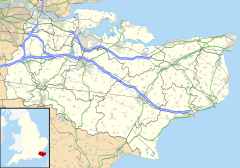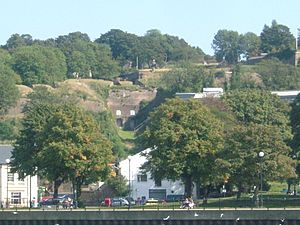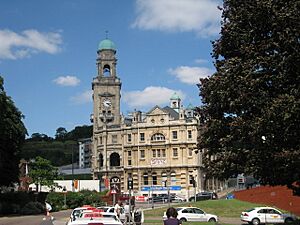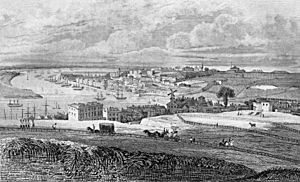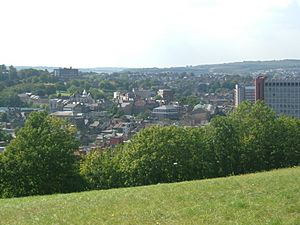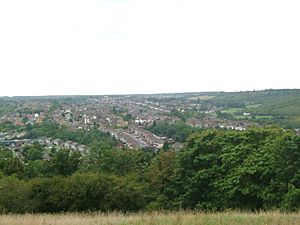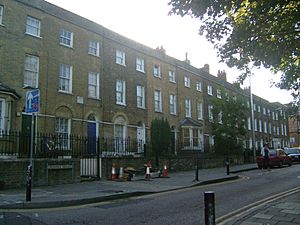Chatham, Kent facts for kids
Quick facts for kids Chatham |
|
|---|---|
| Town | |
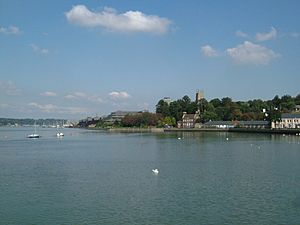 Chatham Riverside from Sun Pier |
|
 Coat of arms of Chatham |
|
| Population | 80,596 (2020 ONS) |
| OS grid reference | TQ765659 |
| • London | 33 mi (53 km) WNW |
| Unitary authority | |
| Ceremonial county | |
| Region | |
| Country | England |
| Sovereign state | United Kingdom |
| Post town | CHATHAM |
| Postcode district | ME4, ME5 |
| Dialling code | 01634 |
| Police | Kent |
| Fire | Kent |
| Ambulance | South East Coast |
| EU Parliament | South East England |
| UK Parliament |
|
Chatham is a town in Medway, Kent, England. It is part of a larger group of towns, including Gillingham, Rochester, Strood, and Rainham. In 2020, about 80,596 people lived here.
Chatham grew up around its important Chatham Dockyard and several army bases. In the 1800s, forts were built to protect the dockyard. The Corps of Royal Engineers, a special army group, is still based in Chatham at Brompton Barracks.
The dockyard closed in 1984. However, many old naval buildings are now popular tourist spots. Part of the old dockyard became a commercial port. Other areas were turned into homes and businesses. The Chatham Historic Dockyard museum is also there. You can even see the submarine HMS Ocelot at the museum.
Chatham has important road and rail links. Its railway and bus stations are key travel hubs for the area. It is also the main shopping center and the administrative headquarters for the Medway area.
Contents
What's in a Name?
The name Chatham was first written down in 880. It appeared as Cætham in 975 and Ceteham in 1086. The first part of the name comes from an old British word meaning "woodland." The second part comes from an Old English word meaning "settlement." So, Chatham means "settlement at the wood."
A Look Back in Time
Chatham is located on the A2 road, which follows an ancient Celtic path. The Romans paved this path, and the Anglo-Saxons later called it Watling Street. Roman cemetery remains have been found here.
For a long time, Chatham was a small village by the river. By the 1500s, warships started to anchor in the nearby Gillingham water. This was because it was a safe, sheltered spot between London and Europe. Queen Elizabeth I officially started the Royal Dockyard in 1568. Most of the dockyard was actually in Gillingham.
At first, the dockyard was used to repair ships. Later, it became a place where ships were built. From then until the late 1800s, the dockyard grew much larger. Thousands of people worked there, and hundreds of ships were built. This included the famous HMS Victory in the 1760s. After World War I, many submarines were also built at Chatham Dockyard.
To protect the dockyard, many forts were built. Upnor Castle was built in 1567, but it didn't work well when the Dutch attacked in 1667. This attack, called the Raid on the Medway, showed that more defenses were needed. Fortifications, like Fort Amherst, began in 1756. They became more complex as the threat of invasion grew.
In the 1800s, even more forts were built to protect against land attacks from the south. These included Fort Pitt (later a hospital) and later Fort Luton, Fort Bridgewood, and Fort Borstal. These forts needed soldiers, so army barracks were built to house them.
As the dockyard grew, so did Chatham and nearby villages. Trams and buses helped people get to work. The area between the High Street and Luton village shows this growth with its many Victorian houses.
The importance of Chatham dockyard slowly decreased. Britain's navy became smaller, and some operations moved elsewhere. Finally, in 1984, the dockyard closed completely. The old dockyard buildings are now part of the Chatham Historic Dockyard site. Part of St Mary's Island is now a marina, and the rest is being developed for homes and businesses, known as "Chatham Maritime."
How Chatham is Governed
Chatham used to be its own borough. But in 1974, it became part of the Borough of Medway. This borough changed its name a few times. In 1998, it became a unitary authority area. This means it manages its own local services, separate from Kent County Council. However, it is still part of Kent for ceremonial events.
Medway Council's main office is now at Gun Wharf. This building used to be an office for Lloyd's of London.
Chatham is part of the Chatham and Aylesford area for national elections. Before 1997, it was part of other constituencies. This area has often changed which political party represents it in Parliament.
Here are some of the Members of Parliament for Chatham since 1945:
| Election | Member | Party | |
|---|---|---|---|
| 1945 | Arthur Bottomley | Labour | |
| 1959 | Julian Critchley | Conservative | |
| 1964 | Anne Kerr | Labour | |
| 1970 | Peggy Fenner | Conservative | |
| Oct 1974 | Robert Bean | Labour | |
| 1979 | Peggy Fenner | Conservative | |
| 1983 | Andrew Rowe | Conservative | |
| 1997 | Jonathan Shaw | Labour | |
| 2010 | Tracey Crouch | Conservative | |
| 2024 | Tristan Osborne | Labour | |
Chatham's Location
Chatham is located where the lower part of the North Downs hills meets the River Medway. The river here flows from south to north. This location gives the town good access to the river. The river is fast-flowing and deep on the side where Chatham stands.
The town is at river level and curves into a valley called "The Brook," where the High Street is. Beyond the dockyard was marshy land, now called St Mary’s Island, which has new housing estates.
The valley continues southeast as the Luton Valley. The Darland Banks, which are the northern slopes of the valley, have natural chalk grassland. The photo (3) shows the village of Luton with its Victorian houses.
Until the early 1900s, most of the southern part of Chatham was countryside with farms and woods. The village of Walderslade began when a builder started to construct homes there.
Population Growth
Chatham became a market town in the 1800s. By 1831, its population was over 16,000 people. By 1961, it had grown to 48,800 people.
What People Do for Work
When the Royal Navy Dockyard closed on March 31, 1984, it changed jobs in the town. About 7,000 people lost their jobs, and the unemployment rate went up. Since then, there has been a big effort to bring new businesses to the area. One of the largest employers in Chatham now is Vanquis Bank Ltd.
Important Places to See
The Chatham Naval Memorial remembers 18,500 Royal Navy officers and sailors who were lost at sea in World War I and World War II. It was built in 1924 and expanded in 1952. It stands on the Great Lines, a ridge between Chatham and Gillingham.
The Chatham Town Hall, built in 1900, is a special building. It became the Medway Arts Centre in 1987, hosting plays and events. In 1997, it was renamed the Brook Theatre.
The Pentagon Shopping Centre is in Chatham Town Centre. It used to have the Pentagon Bus Station, which closed in 2011. The new Chatham Waterfront bus station opened in October 2011. The old bus station, built in 1970, was often crowded and had diesel fumes. The new one is much better for passengers.
Getting Around Chatham
The River Medway has always been important for travel. In the past, it was used to transport goods like stone, timber, and farm products. Today, it is mainly used for tourist boats. There are also many places for yachts to moor.
The road system in Chatham started with the Roman road, Watling Street, which went through the town. Toll roads were set up in the 1700s. The New Road was built in 1769 to bypass the High Street. Later, the M2 motorway was built to take through traffic away from the Medway Towns.
Chatham is a central point for the Medway Towns. This means its roads often get very busy. The High Street is now free of traffic. In 2009, the Sir John Hawkins Flyover was taken down. It was replaced by a street-level road for buses only, and the bus station was moved. The new Waterfront bus station opened in October 2011.
Chatham railway station opened in 1858. It connects the North Kent Line and the Chatham Main Line. Trains run to London Victoria, London Charing Cross, and Luton. There are also high-speed services to St Pancras.
Part of the old industrial railway at Chatham Historic Dockyard still operates. It is run by the North Kent Industrial Locomotive Society.
Buses are operated by Arriva Southern Counties and Nu-Venture. They go to other towns in Medway like Gillingham and Rochester, and also to other towns in Kent like Maidstone and Gravesend. There is also an express bus to Bluewater shopping centre.
Places of Worship
In the 1800s, Chatham's church area included Luton and Brompton. Chatham's main church, St Marys, was rebuilt in 1788. St John's was built in 1821 and is now used for art projects. St Paul's New Road was built in 1854 but was later taken down. St Peter's Troy Town was built in 1860.
St Michael's is a Roman Catholic church built in 1863. There is also a Unitarian Chapel from 1861.
Chatham is thought to be home to the first Baptist chapel in north Kent, the Zion Baptist Chapel. The first known pastor, Edward Morecock, settled there in the 1660s. Chatham Memorial Synagogue was built in 1867.
Schools
For a full list of schools serving Chatham, you can visit List of schools in Medway.
Sports and Activities
Chatham has a football club called Chatham Town F.C.. They play in the Premier Division of the Isthmian League. Lordswood F.C. also plays in the area. Gillingham F.C. represents the wider Medway area.
Holcombe Hockey Club is one of the largest in the country and is based in Chatham. Their men's team plays in the Men's England Hockey League.
You can enjoy kite flying, especially power kiting, at the Great Lines Heritage Park and Capstone Farm Country Park. Skiing is also possible at the Capstone Ski Slope and Snowboard Centre.
Local News and Media
Newspapers
Local newspapers for Chatham include Medway News, Medway Standard, and the Medway Messenger. There are also free newspapers like the Medway Extra and yourmedway.
Radio
The local commercial radio station is KMFM Medway. You can also listen to community radio station Radio Sunlight. Other stations like BBC Radio Kent, Heart, and Gold can be heard here.
Television
Local news and TV shows come from BBC South East and ITV Meridian. These are broadcast from the Bluebell Hill transmitting station.
Famous People from Chatham
The famous writer Charles Dickens lived in Chatham as a boy. He lived in 'The Brook' and Ordnance Terrace. He later said this was the happiest time of his childhood. He eventually moved back to the area as an adult. Medway is mentioned in his novels.
Other notable people who were born or lived in Chatham include:
- Sir Jacob Ackworth (1668–1748), a shipbuilder.
- Asquith Xavier, who helped end racial discrimination at British Railways in London.
- Percy Whitlock, an organist and composer.
- Kid Harpoon, a singer, songwriter, and producer who has worked with artists like Harry Styles.
- Richard Dadd, a Victorian painter.
- Elizabeth Benger, a biographer, novelist, and poet.
- Billy Childish, an artist, poet, and musician.
- Tracey Emin, a famous artist.
- Zandra Rhodes, a designer.
- William Cuffay, a Chartist leader, born in Chatham in 1788.
- Gemma Lavender, an astronomer, journalist, and author, born in Chatham in 1986.
- Thomas Hodgskin, an early socialist whose ideas influenced Karl Marx.
- Joe Machine, an artist and poet.
Entertainers
- Tommy Knight, actor.
- Stel Pavlou, author and screenwriter.
- Lee Ryan, boy-band singer.
- Ben Mills, singer and X-Factor contestant.
- Anne Dudley, composer and musician.
- Kevin Eldon, stand-up comedian.
- Glenn Shorrock, entertainer and lead singer of Little River Band.
- River Medway (drag queen), entertainer.
- Balvinder Sopal, actress.
Sportspeople
- Dave Whitcombe, darts player.
- Kevin Hunt, former football captain.
- Ashley Jackson, England international hockey player.
- Chris Smalling, England international footballer.
- Andrew Crofts, professional footballer.
- Neil Shipperley, professional footballer.
- George Boyd, professional footballer, born in Chatham.
- Lee Minshull, professional footballer, born in Chatham.
- Johnny Armour, professional boxer, born and lives in Chatham.
- George Thorne, professional footballer, born in Chatham.
- Ryan Richards, professional basketball player.
Sister City
Chatham is twinned with Valenciennes, France.
See also
 In Spanish: Chatham (Kent) para niños
In Spanish: Chatham (Kent) para niños


